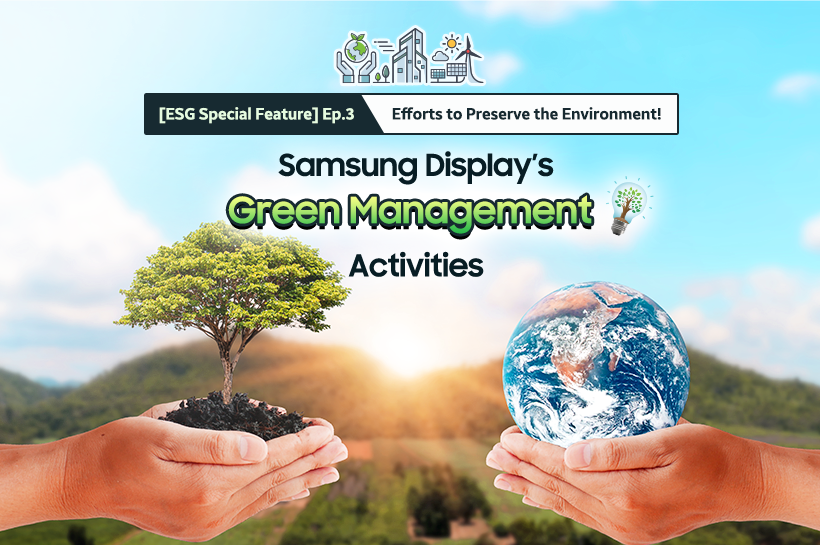
The resource crisis and environmental crisis are accelerating, and there is a lot of interest in environmental protection. Low-carbon, eco-friendly management is no longer an option but a necessity. Climate change is no longer an environmental issue, but a corporate issue. It is at a level that can replace the company’s growth goal itself with the term ‘green growth’.
Samsung Display has been at the forefront of efforts to save the global environment through corporate activities that respect people and nature through ‘Green Management’.
To fulfill our corporate social responsibility, we continue to promote green management that considers human society and the global environment, such as expanding the launch of eco-friendly products and reducing greenhouse gases, based on the 'basic principle of green management' for the affluent life of mankind and the preservation of the global environment.
In this article, we will look at Samsung Display’s ‘Green Management’ journey, which has been leading the global environment preservation and realization of a sustainable society.
Earth is 1.1 degrees hotter than pre-industrial temperature
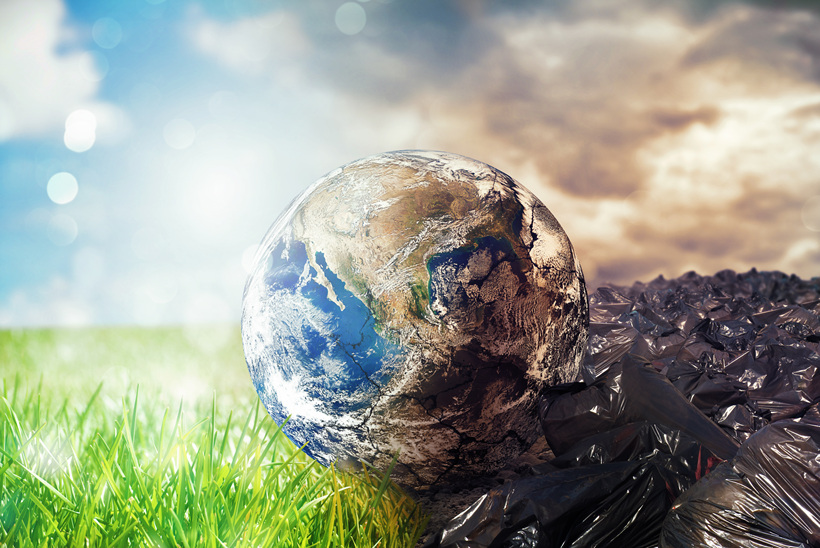
Humanity is paying a harsh price for accelerating industrialization that was instigated in hopes of indulging a more convenient life. Climate change is already causing great damage to countries around the world in various forms such as heat waves, droughts, typhoons, and floods. The amount of carbon dioxide in the Earth's atmosphere is nearly double the amount before the industrial revolution.
According to the ‘Global Climate Report’ recently published by the World Meteorological Organization (WMO), the average temperature between 2015 and 2019 increased by 1.1 degrees Celsius compared to pre-industrial levels. Sea level temperatures are 0.8 degrees warmer than pre-industrial levels, and sea level heights have risen by 90 millimeters since the first measurements were taken in January 1993.
The international community recognized the seriousness of the climate change problem and adopted the Kyoto Protocol in 1997 to impose obligations on developed countries to solve it. Then, in 2015, 195 countries, both developed and developing countries, adopted the Paris Agreement, which agreed to reduce the temperature increase by 2°C and even 1.5°C by 2100. It is a goal chosen by the whole world, not because it is possible, but because it is essential to the survival of mankind.
Samsung Display launches ‘carbon-neutral task force’
To keep pace with the international community moving toward carbon neutrality, Korea also submitted the ‘2030 National Greenhouse Gas Reduction Goal’ and ‘2050 Long-Term Low-Carbon Development Strategy’ to the UN Climate Change Convention Secretariat last year. When the global temperature rises by more than 2℃, natural disasters that ordinary humans cannot handle, such as heat waves and cold waves occur. Limiting the rise temperature to 1.5°C significantly reduces risks to biodiversity, health, livelihoods, food and human security, and economic growth than limiting to 2°C. Small differences lead to huge differences in human survival.
To keep the global temperature, rise within 1.5℃, it is necessary to transition to a carbon-neutral society in which net carbon emissions will be zero by 2050. 2050 Carbon neutrality is a bold challenge to change the industry and energy structure and responding to the climate crisis is no longer an option, it is a necessity.

Samsung Display is also working to minimize environmental impact by forming a carbon-neutral task force in accordance with the government's declaration of the 2050 carbon-neutral vision for Korea. Aligning with the previous declaration, Samsung Display has also established a carbon-neutral promotion strategy and is preparing to achieve the goal.
Since last February, a carbon-neutral task force has been formed to discover tasks every month. Last March, Samsung participated in the launching ceremony of the 'Semiconductor Display Carbon Neutral Committee' hosted by the Ministry of Trade, Industry and Energy to jointly declare carbon neutrality and in April participated in the ‘Climate Change Week’ event held by the Ministry of Environment and pledged to convert all company-related vehicles to eco-friendly automobiles.
Samsung Display's vision to lead green management
For green management activities, Samsung Display is pursuing sustainable growth under five environmental safety policies:
- Strengthening the global environmental and safety management system
- Practice of product stewardship throughout the entire process
- Realizing a safe workplace
- Minimizing environmental impact in the production process
- Forming a win-win partnership based on environment-safety
In addition to complying with domestic and international laws and agreements, the company has set strict internal regulations. Samsung strives to minimize overall environmental impact by purchasing raw materials, parts, and packaging that do not contain harmful substances and by reducing the emission of pollutants and chemicals generated during the production process.
Samsung Display hopes to realize a sustainable society by following management principles that value environment, safety, and health. Ho-jung Lee, Environmental Affairs Lead, noted, “We always share environmental and safety management methods and related technologies with our partners. Our win-win partnership is also based on environmental safety.” So, how is this green management practiced in the field?
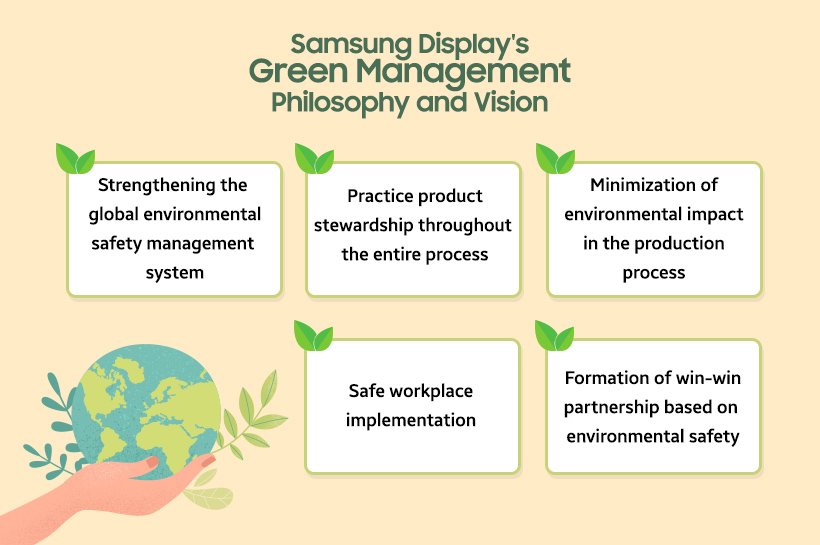
Thorough management from every process step!
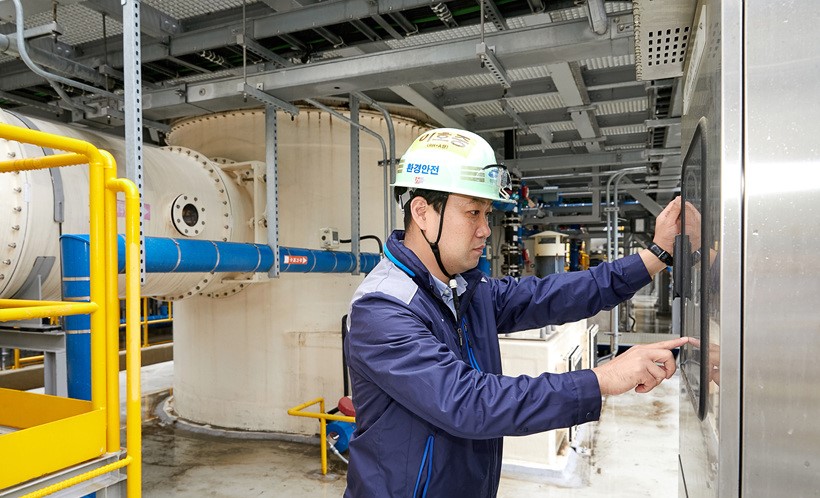
Reducing greenhouse gas emissions has become a global challenge. Samsung Display is implementing greenhouse gas reduction activities in all process lines, for example, operating greenhouse gas reduction facilities in the production process and developing alternative gases. Since 2019, the company carries out activities such as identifying the current reduction status and supplementing necessary areas to increase the efficiency of greenhouse gas reduction. As a result, greenhouse gas emissions such as carbon dioxide and fluorinated gas have decreased every year - reducing greenhouse gas emissions by about 440,000 tons in 2020 compared to 2 years ago. This is the equivalent of creating about 66.7 million pine forests, under the assumption that one 30-year-old pine tree absorbs 6.6 kg of carbon dioxide per year.
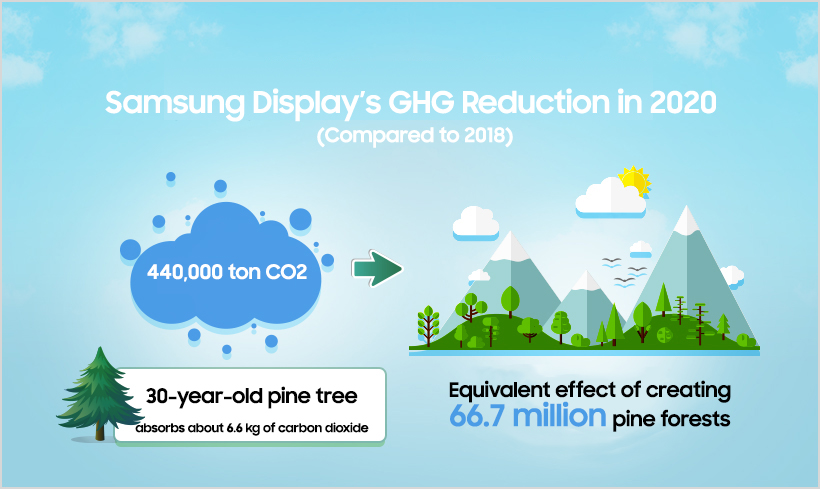
In addition, Samsung Display installed high-efficiency treatment facilities to reduce air pollutants generated at our worksites to reduce nitrogen oxides, a major component of fine dust, and set a goal to cut air pollutants in half by 2023 compared to 2018.

The same goes for water management. Industrial water used by Samsung Display is treated with ultra-pure water before being used in the process, and the used ultra-pure water is reused after going through a post-treatment process. From the stage of use, wastewater discharge water quality management is strictly enforced. The highlight of this reuse of water resources is cooperation with local communities.
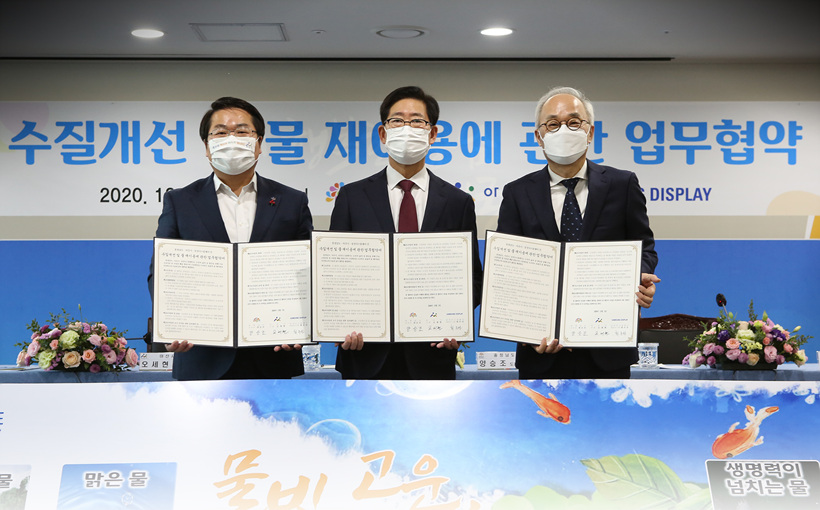
At the end of last year, Samsung Display signed an agreement to ‘reuse water as an effort to improve water quality’ with Asan City to protect water resources in the Chungcheongnam-do region. After Samsung Display treats the water used in the display process cleanly through the Green Center, it supplies 20,000 tons of water per day to two rivers in areas where water is scarce to improve water quality, and some of them are used for agricultural water. Samsung Display has been conducting water treatment with stricter internal regulations than legal standards. Thanks to this, the treated effluent quality is maintained at 30% or less (based on organic matter) compared to the legal standard.
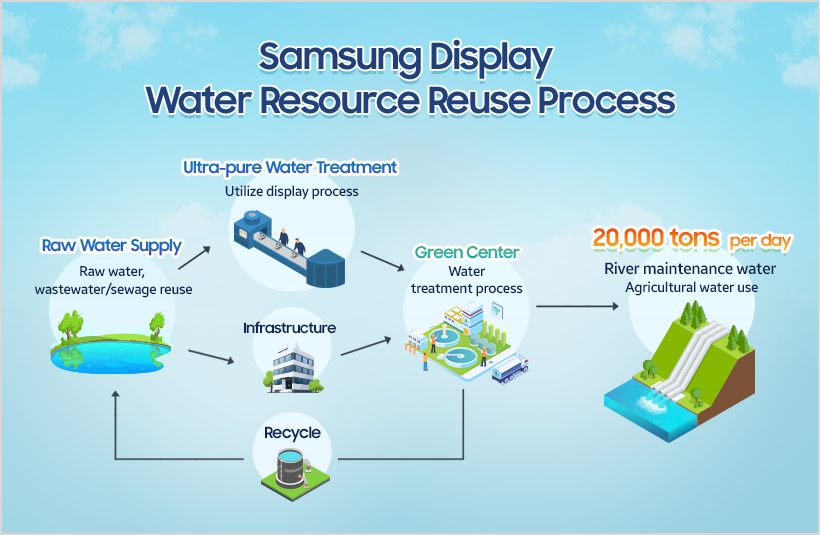
Products are eco-friendly, and industrial waste management is safe and clean!
Samsung Display operates an Eco-Partner certification system to practice product stewardship throughout the entire process. To manage hazardous substances contained in parts and raw materials and to establish an environmental quality management system, it is a system that allows all domestic and foreign parts suppliers to pass the eco-partner certification system to enable trading. Thanks to our efforts to produce eco-friendly products with our eco-partners, in March of this year, the Galaxy Note 20 obtained the 'Environmental Report Card' certification. Not only this year, but Samsung Display has been continuously acquiring the OLED environmental label certification for smartphones. Especially, Foldable OLED succeeded in obtaining certifications for all seven items related to carbon footprint, acid rain, eutrophication, water footprint, resource footprint, ozone layer, and smog.
A burgeoning topic of discussion - industrial waste - is no exception. Various activities are being carried out to safely manage and recycle industrial waste to reduce emissions. Liquid waste generated during the manufacturing process is recycled by filtering impurities, and a resource recycling center is operated to decompose and separate waste display products by material.
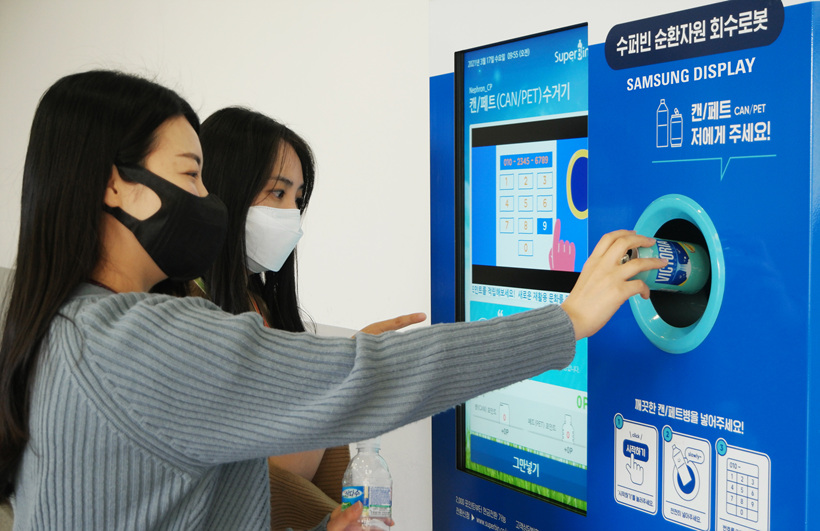
In addition, we strive to reduce household waste such as various plastics, paper, and food generated at our worksites. We are also conducting a campaign to encourage employees to separate collection and introducing a smart recycling bin to establish a corporate culture that allows them to think about recycling resources and manage them voluntarily. In 2019, Samsung Display obtained a 'Gold' level in the field of zero waste landfill from UL, the global safety science company, at its 1st Asan Plant, and in 2020, successfully acquired the highest grade of 'Platinum' for its consistent efforts.
Various efforts to preserve the environment of the local community
Samsung Display is carrying out various activities to preserve the environment of local communities.
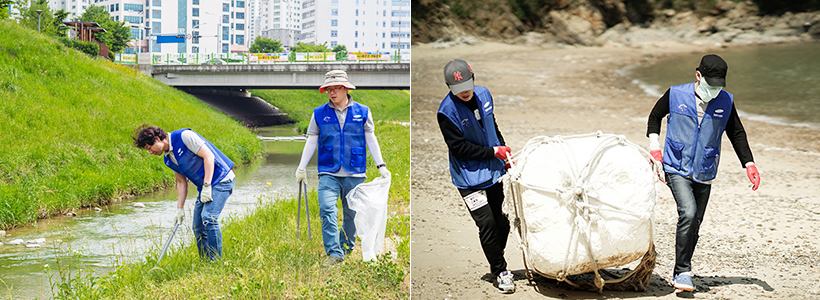
In collaboration with Asan (city in Korea), 'One Company, One Stream Care’ campaign is held every year to remove and purify river disturbance plants in a local stream. Ecological conservation activities are also being carried out. In an effort to reduce fine dust and prevent damage, 'One Company, One Road Clean Responsibility System' campaign is held to spray water on nearby roads as well as business sites. 'One Company, One Forest Planting’ agreement is in place to realize carbon neutrality as Samsung Display plans to plant trees on allocated lands.

Now is the time for companies to take accountability for society, environment, and global community. In order to achieve sustainable development, Samsung Display has been committed to various green management activities such as preserving the environment and cooperating with local communities. Moving forward, Samsung Display will take active steps in implementing green management strategies and hope to inspire other companies in the process.

